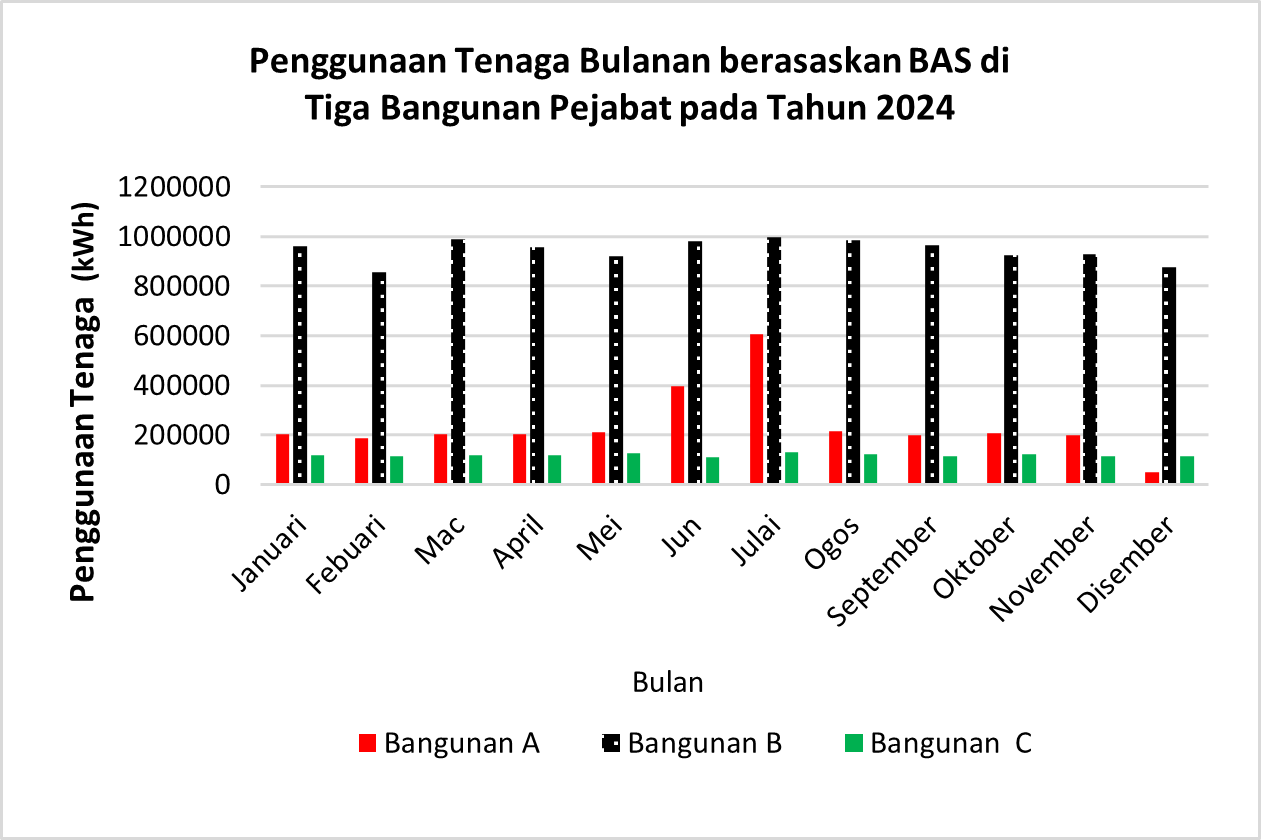The Role of Building Automation System in Malaysia Office Buildings: Challenges and Opportunities for Energy Optimization
Peranan Sistem Automasi Bangunan di Bangunan Pejabat di Malaysia: Cabaran dan Peluang Pengoptimuman Tenaga
DOI:
https://doi.org/10.37934/progee.31.2.117Abstract
Building Automation Systems (BAS) is crucial for integrating and controlling building systems such as heating, ventilating, and air conditioning (HVAC), lighting, and security to enhance energy efficiency, cost savings, and operational functionality in office buildings. This study examines the implementation of BAS in three high-rise office buildings in the central region of Malaysia using a mixed-methods approach, including interviews, literature review, and energy data analysis. The findings reveal that BAS significantly optimizes energy consumption while enabling real-time monitoring and predictive maintenance. However, challenges such as high costs, integration of legacy systems, and technical skill gaps hinder BAS adoption. A comparative analysis indicates varying levels of BAS sophistication, with modern systems achieving measurable energy and cost savings. This study highlights the potential of BAS in supporting Malaysia’s sustainability goals and recommends open standards, stakeholder engagement, and government incentives to overcome adoption barriers and maximize BAS benefits.
Sistem Automasi Bangunan (BAS) adalah penting dalam mengintegrasikan dan mengawal sistem bangunan seperti pemanasan, pengudaraan dan penyaman udara (HVAC), pencahayaan dan keselamatan bagi meningkatkan kecekapan tenaga, penjimatan kos dan fungsi operasi dalam bangunan pejabat. Kajian ini meneliti pelaksanaan BAS di tiga bangunan pejabat bertingkat tinggi di wilayah tengah Malaysia melalui pendekatan penyelidikan kaedah campuran termasuk temu bual, tinjauan literatur, dan analisis data tenaga. Kajian ini mendapati bahawa BAS secara signifikan mengoptimumkan penggunaan tenaga serta membolehkan pemantauan masa nyata dan penyelenggaraan ramalan, namun cabaran seperti kos yang tinggi, integrasi sistem lama, dan jurang kemahiran teknikal menghalang penerimaan penggunaan BAS. Analisis perbandingan menunjukkan tahap kecanggihan BAS yang berbeza-beza, di mana sistem moden mencapai penjimatan tenaga dan kos yang boleh diukur. Kajian ini menekankan potensi BAS dalam menyokong matlamat kelestarian Malaysia dan mencadangkan piawaian terbuka, penglibatan pihak berkepentingan, serta insentif kerajaan untuk mengatasi halangan pelaksanaan dan memaksimumkan manfaat BAS.
References
[1] F. Shu, Malka. N. Halgamuge, and W. Chen, Building Automation Systems Using Wireless Sensor Networks: Radio Characteristics and Energy Efficient Communication Protocols. Electronic Journal of Structural Engineering 01 (2009) 66–73. https://doi.org/10.56748/ejse.11101
[2] S. C. Chua and T. H. Oh, Review on Malaysia’s National Energy Developments: Key Policies, Agencies, Programmes and International Involvements. Renewable and Sustainable Energy Reviews 14(9) (2010) 2916–2925. https://doi.org/10.1016/j.rser.2010.07.031
[3] E. M. Erebor, E. O. Ibem, I. C. Ezema, and A. B. Sholanke, Energy Efficiency Design Strategies in Office Buildings: A Literature IOP Conference Series: Earth and Environmental Science 665(1) (2021) 012025. https://doi.org/10.1088/1755-1315/665/1/012025
[4] S. Barlow and D. Fiala, Occupant Comfort in UK offices—How Adaptive Comfort Theories might Influence Future Low Energy Office Refurbishment Strategies. Energy and Buildings 39(7) (2007) 837–846. https://doi.org/10.1016/j.enbuild.2007.02.002
[5] X. Xu, P. J. Culligan, and J. E. Taylor, Energy Saving Alignment Strategy: Achieving Energy Efficiency in Urban Buildings by Matching Occupant Temperature Preferences with a Building’s Indoor Thermal Environment. Applied Energy (123) (2014) 209–219. https://doi.org/10.1016/j.apenergy.2014.02.039
[6] N. Fernandez, S. Katipamula, W. Wang, Y. Huang, and G. Liu, Energy Savings Modeling of Standard Commercial Building Re-tuning Measures: Large Office Buildings. OSTI OAI (U.S. Department of Energy Office of Scientific and Technical Information, 2012. https://doi.org/10.2172/1048616
[7] V. Mistry, Energy Efficiency in HVAC Systems through Building Automation. Journal of Biosensors and Bioelectronics Research 1(1) (2023) 1-4. https://doi.org/10.47363/JBBER/2023(1)113
[8] P. Lamsal, S. B. Bajracharya, and H. B. Rijal, A Review on Adaptive Thermal Comfort of Office Building for Energy-Saving Building Design. Energies 16(3) (2023) 1524. https://doi.org/10.3390/en16031524.
[9] D. Ramsauer, M. Dorfmann, H. Tellioğlu, and W. Kastner, Human Perception and Building Automation Systems. Energies 15(5) (2022) 1745. https://doi.org/10.3390/en15051745
[10] Z. Pang, P. Xu, Z. O’Neill, J. Gu, X. Lu, and X. Li, Application of mobile positioning occupancy data for building energy simulation: An engineering case study. Building and Environment 141 (2018) 1–15. https://doi.org/10.1016/j.buildenv.2018.05.030
[11] D. H. Wang and K. W. E. Cheng, General Discussion on Energy Saving. In: Proceedings. 2004 First International Conference on Power Electronics Systems and Applications, 2004., Hong Kong, China, 2004, pp. 298-303.
[12] W. Wang, T. Hong, N. Li, R. Q. Wang, and J. Chen, Linking Energy-Cyber-Physical Systems with Occupancy Prediction and Interpretation through WiFi Probe-Based Ensemble Classification. Applied Energy 236 (2019) 55–69. https://doi.org/10.1016/j.apenergy.2018.11.079
[13] I. González, A. J. Calderón, A. Mejías, and J. M. Andújar, Novel Networked Remote Laboratory Architecture for Open Connectivity Based on PLC-OPC-LabVIEW-EJS Integration. Application in Remote Fuzzy Control and Sensors Data Acquisition. Sensors 16(11) (2016) 1822. https://doi.org/10.3390/S16111822
[14] Y. Zhang, Z. Yan, F. Yuan, J. Yao, and B. Ding, A Novel Reconstruction Approach to Elevator Energy Conservation based on a DC Micro-Grid in High-Rise Buildings. Energies 12(1) (2019) 33. https://doi.org/10.3390/en12010033
[15] G. Lowry, Energy Saving Claims for Lighting Controls in Commercial Buildings. Energy and Buildings 133 (2016) 489–497. https://doi.org/10.1016/J.ENBUILD.2016.10.003
[16] K. R. Wagiman, M. N. Abdullah, M. Y. Hassan, and N. H. Mohammad Radzi, A New Metric for Optimal Visual Comfort and Energy Efficiency of Building Lighting System Considering Daylight using Multi-Objective Particle Swarm Optimization. Journal of Building Engineering 43 (2021) 102525. https://doi.org/10.1016/J.JOBE.2021.102525
[17] B. Roisin, M. Bodart, A. Deneyer, and P. D’Herdt, Lighting Energy Savings in Offices using Different Control Systems and Their Real Consumption. Energy and Buildings 40(4) (2008) 514–523. https://doi.org/10.1016/J.ENBUILD.2007.04.006
[18] N. Gentile, T. Laike, and M. C. Dubois, Lighting Control Systems in Individual Offices Rooms at High Latitude: Measurements of Electricity Savings and Occupants’ Satisfaction. Solar Energy 127 (2016) 113–123. https://doi.org/10.1016/J.SOLENER.2015.12.053
[19] A. Shankar, V. Krishnasamy, and B. Chitti Babu, Smart LED Lighting System with Occupants’ Preference and Daylight Harvesting in Office Buildings. Energy Sources, Part A: Recovery, Utilization, and Environmental Effects 47(1) (2025) 3966–3986. https://doi.org/10.1080/15567036.2020.1859650
[20] V. S. K. V. Harish and A. Kumar, A Review on Modeling and Simulation of Building Energy Systems. Renewable and Sustainable Energy Reviews 56 (2016) 1272–1292. https://doi.org/10.1016/j.rser.2015.12.040
[21] A. Verma, S. Prakash, and A. Kumar, AI-based Building Management and Information System with Multi-agent Topology for an Energy-efficient Building: Towards Occupants Comfort. IETE Journal of Research 69(2) (2023) 1033–1044, Feb. 2023. https://doi.org/10.1080/03772063.2020.1847701
[22] A. Mirakhorli and B. Dong, Occupancy Behavior based Model Predictive Control for Building Indoor Climate—A Critical Review. Energy and Buildings 129 (2016) 499–513. https://doi.org/10.1016/j.enbuild.2016.07.036
[23] P. Domingues, P. Carreira, R. Vieira, and W. Kastner, Building Automation Systems: Concepts and Technology Review. Computer Standards & Interfaces 45 (2016) 1–12. https://doi.org/10.1016/j.csi.2015.11.005
[24] Z. Afroz, G. Shafiullah, T. Urmee, and G. Higgins, Modeling Techniques used in Building HVAC Control Systems: A Review. Renewable and Sustainable Energy Reviews 83 (2018) 64–84. https://doi.org/10.1016/j.rser.2017.10.044
[25] Y. Jin, D. Yan, A. Chong, B. Dong, and J. An, Building Occupancy Forecasting: A Systematical and Critical Review. Energy and Buildings 251 (2021) 111345. https://doi.org/10.1016/j.enbuild.2021.111345
[26] D. Chakraborty and H. Elzarka, Early Detection of Faults in HVAC Systems using an XGBoost Model with a Dynamic Threshold. Energy and Buildings 185 (2019) 326–344. https://doi.org/10.1016/j.enbuild.2018.12.032
[27] H. Kramer, G. Lin, C. Curtin, E. Crowe, and J. Granderson, Building Analytics and Monitoring-Based Commissioning: Industry Practice, Costs, and Savings. Energy Efficiency 13(3) (2020) 537–549. https://doi.org/10.1007/s12053-019-09790-2
[28] J. Ock, R. R. A. Issa, and I. Flood, Smart Building Energy Management Systems (BEMS) Simulation Conceptual Framework. In: 2016 Winter Simulation Conference (WSC), IEEE, Dec. 2016, pp. 3237–3245. https://doi.org/10.1109/WSC.2016.7822355
[29] H. Burak Gunay, W. Shen, and G. Newsham, Data Analytics to Improve Building Performance: A Critical Review. Automation in Construction 97 (2019) 96–109. https://doi.org/10.1016/j.autcon.2018.10.020
[30] J. Y. Park, M. M. Ouf, B. Gunay, Y. Peng, W. O’Brien, M. B. Kjærgaard, and Z. Nagy, A Critical Review of Field Implementations of Occupant-Centric Building Controls. Building and Environment 165 (2019) 106351. https://doi.org/10.1016/j.buildenv.2019.106351
[31] J. S. Hassan, R. M. Zin, M. Z. Abd Majid, S. Balubaid, M. R. Hainin, and J. Bahru, Building Energy Consumption in Malaysia: An Overview. 70(7) (2014) 33-38. https://doi.org/10.11113/jt.v70.3574
[32] M. K. M. Shapi, N. A. Ramli, and L. J. Awalin, Energy Consumption Prediction by using Machine Learning for Smart Building: Case Study in Malaysia. Developments in the Built Environment 5 (2021) 100037. https://doi.org/10.1016/J.DIBE.2020.100037
[33] Delshya Selvaraj, Using a Building Automation System for Energy Audits. Retrieved from: https://facilio.com/blog/energy-audits-with-a-bas/ (accessed on Jan. 16, 2025).
[34] S. van Roosmale, P. Hellinckx, J. Meysman, S. Verbeke, and A. Audenaert, Building Automation and Control Systems for Office Buildings: Technical Insights for Effective Facility Management - A Literature Review. Journal of Building Engineering 97 (2024) 110943. https://doi.org/10.1016/J.JOBE.2024.110943

Downloads
Published
Issue
Section
License
Copyright (c) 2025 Progress in Energy and Environment

This work is licensed under a Creative Commons Attribution-NonCommercial 4.0 International License.















